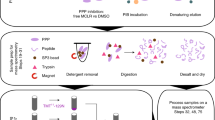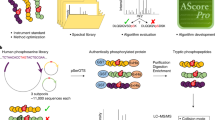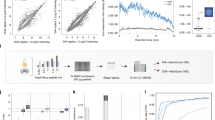Abstract
The ability to routinely analyze and quantitatively measure changes in protein phosphorylation on a proteome-wide scale is essential for biological and clinical research. We assessed the ability of three common phosphopeptide isolation methods (phosphoramidate chemistry (PAC), immobilized metal affinity chromatography (IMAC) and titanium dioxide) to reproducibly, specifically and comprehensively isolate phosphopeptides from complex mixtures. Phosphopeptides were isolated from aliquots of a tryptic digest of the cytosolic fraction of Drosophila melanogaster Kc167 cells and analyzed by liquid chromatography–electrospray ionization tandem mass spectrometry. Each method reproducibly isolated phosphopeptides. The methods, however, differed in their specificity of isolation and, notably, in the set of phosphopeptides isolated. The results suggest that the three methods detect different, partially overlapping segments of the phosphoproteome and that, at present, no single method is sufficient for a comprehensive phosphoproteome analysis.
This is a preview of subscription content, access via your institution
Access options
Subscribe to this journal
Receive 12 print issues and online access
$259.00 per year
only $21.58 per issue
Buy this article
- Purchase on Springer Link
- Instant access to full article PDF
Prices may be subject to local taxes which are calculated during checkout





Similar content being viewed by others
References
Garavelli, J.S. The RESID Database of Protein Modifications as a resource and annotation tool. Proteomics 4, 1527–1533 (2004).
Hunter, T. Signaling - 2000 and beyond. Cell 100, 113–127 (2000).
Aebersold, R. & Goodlett, D.R. Mass spectrometry in proteomics. Chem. Rev. 101, 269–295 (2001).
Sachon, E., Mohammed, S., Bache, N. & Jensen, O.N. Phosphopeptide quantitation using amine-reactive isobaric tagging reagents and tandem mass spectrometry: application to proteins isolated by gel electrophoresis. Rapid Commun. Mass Sp. 20, 1127–1134 (2006).
Goshe, M.B. et al. Phosphoprotein isotope-coded affinity tag approach for isolating and quantitating phosphopeptides in proteome-wide analyses. Anal. Chem. 73, 2578–2586 (2001).
Blagoev, B., Ong, S.E., Kratchmarova, I. & Mann, M. Temporal analysis of phosphotyrosine-dependent signaling networks by quantitative proteomics. Nat. Biotechnol. 22, 1139–1145 (2004).
Gruhler, A. et al. Quantitative phosphoproteomics applied to the yeast pheromone signaling pathway. Mol. Cell. Proteomics 4, 310–327 (2005).
Tao, W.A. et al. Quantitative phosphoproteome analysis using a dendrimer conjugation chemistry and tandem mass spectrometry. Nat. Methods 2, 591–598 (2005).
Zhou, H., Watts, J.D. & Aebersold, R. A systematic approach to the analysis of protein phosphorylation. Nat. Biotechnol. 19, 375–378 (2001).
Reinders, J. & Sickmann, A. State-of-the-art in phosphoproteomics. Proteomics 5, 4052–4061 (2005).
Gold, M.R. et al. Purification and identification of tyrosine-phosphorylated proteins from B lymphocytes stimulated through the antigen receptor. Electrophoresis 15, 441–453 (1994).
Kanakura, Y., Druker, B., DiCarlo, J., Cannistra, S.A. & Griffin, J.D. Phorbol 12-myristate 13-acetate inhibits granulocyte-macrophage colony stimulating factor-induced protein tyrosine phosphorylation in a human factor-dependent hematopoietic cell line. J. Biol. Chem. 266, 490–495 (1991).
Andersson, L. & Porath, J. Isolation of phosphoproteins by immobilized metal (Fe-3+) affinity-chromatography. Anal. Biochem. 154, 250–254 (1986).
Rush, J. et al. Immunoaffinity profiling of tyrosine phosphorylation in cancer cells. Nat. Biotechnol. 23, 94–101 (2005).
Li, S. & Dass, C. Iron(III)-immobilized metal ion affinity chromatography and mass spectrometry for the purification and characterization of synthetic phosphopeptides. Anal. Biochem. 270, 9–14 (1999).
Knight, Z.A. et al. Phosphospecific proteolysis for mapping sites of protein phosphorylation. Nat. Biotechnol. 21, 1047–1054 (2003).
Oda, Y., Nagasu, T. & Chait, B.T. Enrichment analysis of phosphorylated proteins as a tool for probing the phosphoproteome. Nat. Biotechnol. 19, 379–382 (2001).
Bodenmiller, B. et al. An integrated chemical, mass spectrometric and computational strategy for phosphoproteome analysis: application to human jurkat T cells. Mol. Biosyst. (in the press).
Posewitz, M.C. & Tempst, P. Immobilized gallium(III) affinity chromatography of phosphopeptides. Anal. Chem. 71, 2883–2892 (1999).
Larsen, M.R., Thingholm, T.E., Jensen, O.N., Roepstorff, P. & Jorgensen, T.J. Highly selective enrichment of phosphorylated peptides from peptide mixtures using titanium dioxide microcolumns. Mol. Cell. Proteomics 4, 873–886 (2005).
Pinkse, M.W.H., Uitto, P.M., Hilhorst, M.J., Ooms, B. & Heck, A.J.R. Selective isolation at the femtomole level of phosphopeptides from proteolytic digests using 2D-nanoLC-ESI-MS/MS and titanium oxide precolumns. Anal. Chem. 76, 3935–3943 (2004).
Kweon, H.K. & Hakansson, K. Selective zirconium dioxide-based enrichment of phosphorylated peptides for mass spectrometric analysis. Anal. Chem. 78, 1743–1749 (2006).
Cao, P. & Stults, J.T. Phosphopeptide analysis by on-line immobilized metal-ion affinity chromatography-capillary electrophoresis-electrospray ionization mass spectrometry. J. Chromatogr. A. 853, 225–235 (1999).
Ficarro, S.B. et al. Phosphoproteome analysis by mass spectrometry and its application to Saccharomyces cerevisiae. Nat. Biotechnol. 20, 301–305 (2002).
Nuhse, T.S., Stensballe, A., Jensen, O.N. & Peck, S.C. Large-scale analysis of in vivo phosphorylated membrane proteins by immobilized metal ion affinity chromatography and mass spectrometry. Mol. Cell. Proteomics 2, 1234–1243 (2003).
Elias, J.E., Haas, W., Faherty, B.K. & Gygi, S.P. Comparative evaluation of mass spectrometry platforms used in large-scale proteomics investigations. Nat. Methods 2, 667–675 (2005).
Mann, M. et al. Analysis of protein phosphorylation using mass spectrometry: deciphering the phosphoproteome. Trends Biotechnol. 20, 261–268 (2002).
Schwartz, D. & Gygi, S.P. An iterative statistical approach to the identification of protein phosphorylation motifs from large-scale data sets. Nat. Biotechnol. 23, 1391–1398 (2005).
Schlosser, A., Pipkorn, R., Bossemeyer, D. & Lehmann, W.D. Analysis of protein phosphorylation by a combination of elastase digestion and neutral loss tandem mass spectrometry. Anal. Chem. 73, 170–176 (2001).
Larsen, M.R., Graham, M.E., Robinson, P.J. & Roepstorff, P. Improved detection of hydrophilic phosphopeptides using graphite powder microcolumns and mass spectrometry: evidence for in vivo doubly phosphorylated dynamin I and dynamin III. Mol. Cell. Proteomics 3, 456–465 (2004).
Keller, A., Nesvizhskii, A.I., Kolker, E. & Aebersold, R. Empirical statistical model to estimate the accuracy of peptide identifications made by MS/MS and database search. Anal. Chem. 74, 5383–5392 (2002).
Acknowledgements
We thank O. Rinner, J. Malmström, P. Picotti and M. Larsen for fruitful discussions. This project has been funded in part by ETH Zurich and by federal funds from the US National Heart, Lung, and Blood Institute of the National Institutes of Health (N01-HV-28179). B.B. is the recipient of a fellowship by the Boehringer Ingelheim Fonds.
Author information
Authors and Affiliations
Corresponding author
Ethics declarations
Competing interests
The authors declare no competing financial interests.
Supplementary information
Supplementary Fig. 1
Amino acid usage of the identified (phospho)peptides compared to the starting material and the used protein database. (PDF 88 kb)
Supplementary Fig. 2
The influence of the peptide to resin ratio on the selectivity and percentage of singly phosphorylated peptides in the case of pTiO2. (PDF 66 kb)
Supplementary Fig. 3
The influence of the peptide to resin ratio on the selectivity and percentage of singly phosphorylated peptides in the case of IMAC. (PDF 21 kb)
Supplementary Table 1
Values of the similarity and overlap between any two LC-MS runs as computed by Superhirn. (PDF 99 kb)
Supplementary Table 2
Phosphopeptides identified with PAC, IMAC, pTiO2 and dhbTiO2. (PDF 214 kb)
Supplementary Table 3
Influence of methylation prior and/or after phosphopeptide isolation using IMAC. (PDF 156 kb)
Rights and permissions
About this article
Cite this article
Bodenmiller, B., Mueller, L., Mueller, M. et al. Reproducible isolation of distinct, overlapping segments of the phosphoproteome. Nat Methods 4, 231–237 (2007). https://doi.org/10.1038/nmeth1005
Received:
Accepted:
Published:
Issue Date:
DOI: https://doi.org/10.1038/nmeth1005
This article is cited by
-
A DNA-PK phosphorylation site on MET regulates its signaling interface with the DNA damage response
Oncogene (2023)
-
An oncogene addiction phosphorylation signature and its derived scores inform tumor responsiveness to targeted therapies
Cellular and Molecular Life Sciences (2023)
-
Cyclic immonium ion of lactyllysine reveals widespread lactylation in the human proteome
Nature Methods (2022)
-
Current Trends in the Analysis of Post-translational Modifications
Chromatographia (2020)



